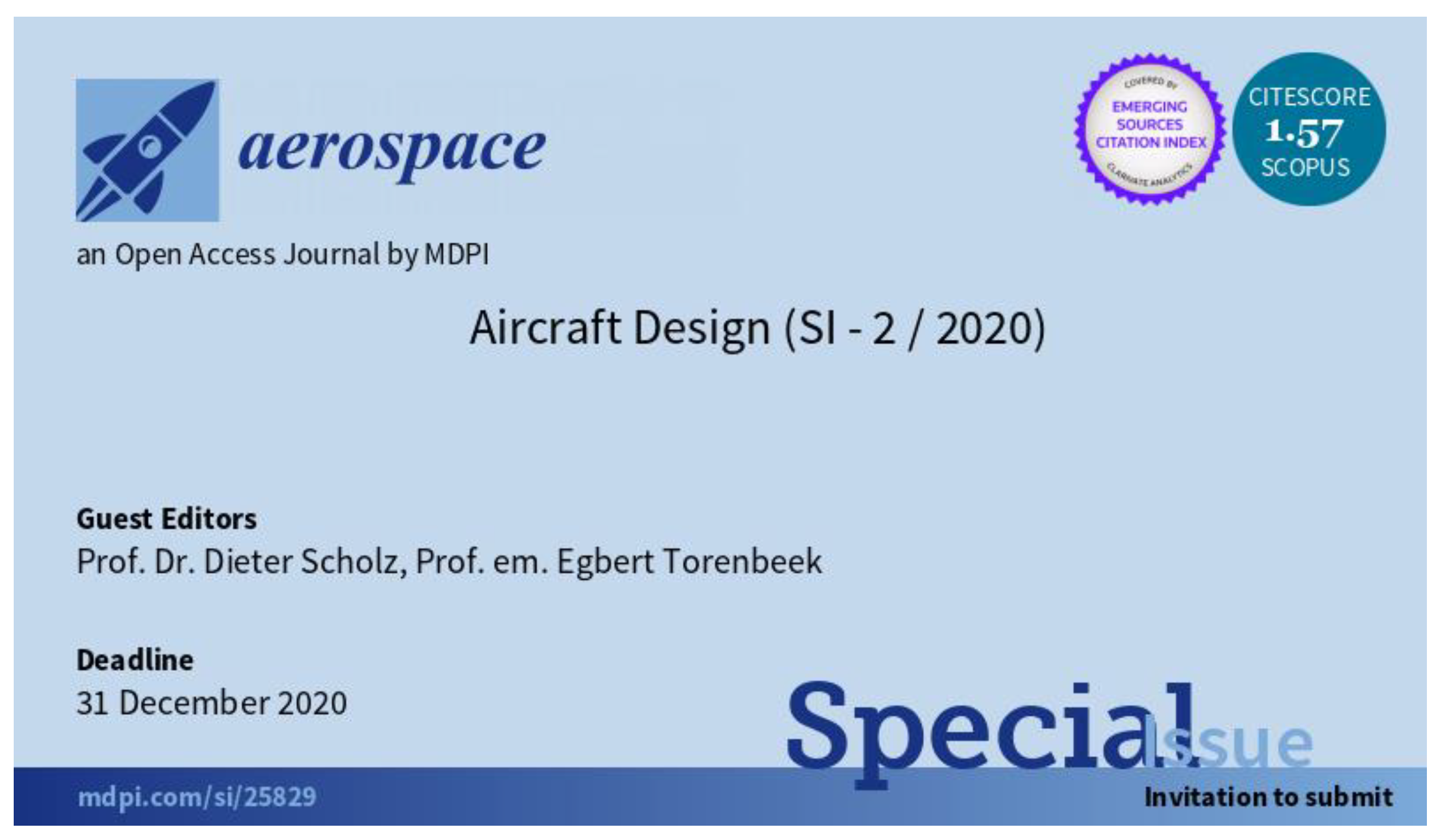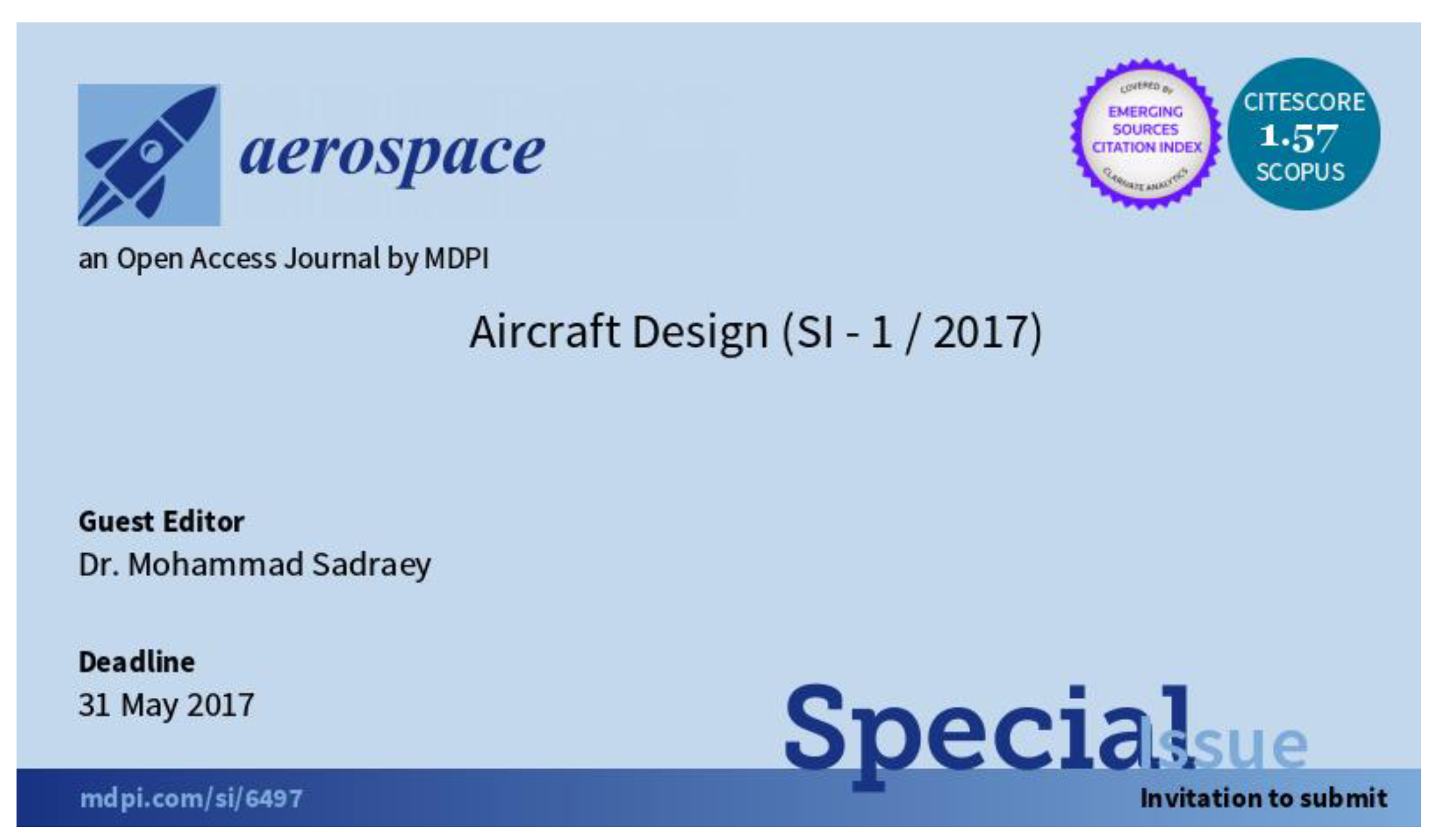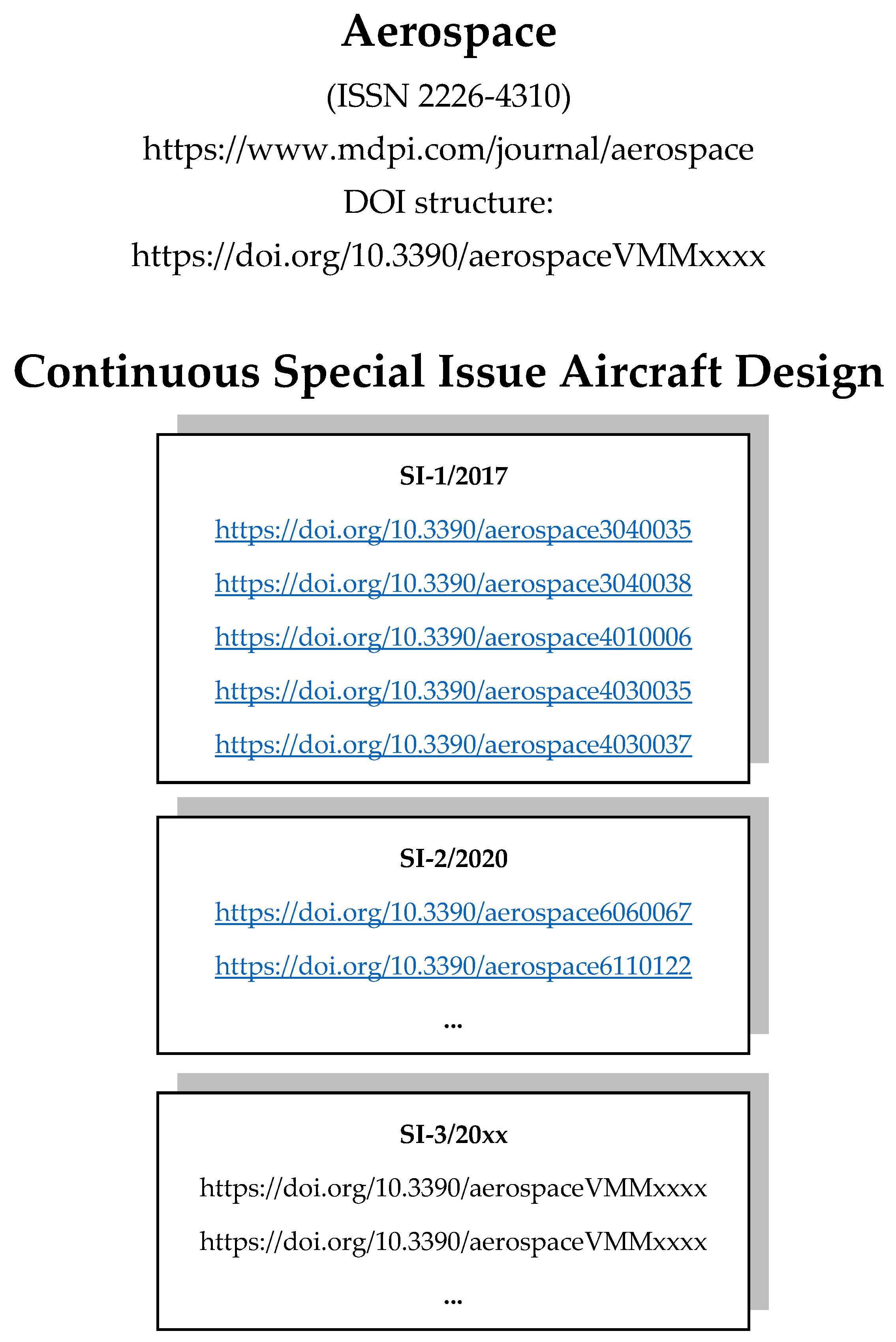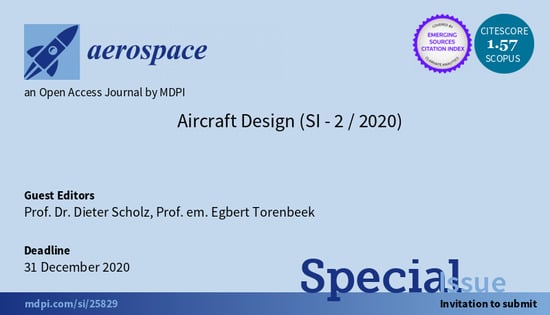Publishing in “Aircraft Design” with a Continuous Open Access Special Issue
Abstract
:1. Introduction
2. Set Up of the Special Issue “Aircraft Design”
3. Aims and Scope
- Innovative aircraft concepts (Figure 4);
- Methodologies and tools for aircraft design and optimization;
- Reference aircraft designs and case studies with datasets; and
- Aircraft design education.
4. The Journal “Aerospace” at MDPI
5. Aircraft Design
6. Summary
Funding
Conflicts of Interest
Abbreviations
| AIAA | American Institute of Aeronautics and Astronautics (www.aiaa.org) |
| CC | Creative Commons (www.creativecommons.org) |
| CEAS | Council of European Aerospace Societies (www.ceas.org) |
| CLOCKSS | Controlled LOCKSS (www.clockss.org) |
| COPE | Committee on Publication Ethics (www.publicationethics.org) |
| CS | CiteScore [34] |
| CWTS | Centre for Science and Technology Studies (www.cwts.nl) |
| DGLR | Deutsche Gesellschaft für Luft- und Raumfahrt Lilienthal-Oberth e.V. (www.dglr.de) |
| DOC | Direct Operating Costs |
| DOI | Digital Object Identifier (www.doi.org) |
| EWADE | European Workshop on Aircraft Design Education (www.ewade.aircraftdesign.org) |
| ISSN | International Standard Serial Number (www.issn.org) |
| LOCKSS | Lots of Copies Keep Stuff Safe (www.lockss.org) |
| MDPI | Multidisciplinary Digital Publishing Institute (www.mdpi.com) |
| OAD | Overall Aircraft Design |
| OASPA | Open Access Scholarly Publishers Association (www.oaspa.org) |
| READ | Research and Education in Aircraft Design (www.read.aircraftdesign.org) |
| SCAD | Symposium on Collaboration in Aircraft Design (www.scad.aircraftdesign.org) |
| SI | Special Issue |
| SNIP | Source Normalized Impact per Paper [34] |
| SRJ | SCImago Journal Rank [34] |
| STM | Here: The worldwide association of STM publishers (www.stm-assoc.org); |
| STM | Science, Technology and Medicine |
| TCAD | CEAS Technical Committee Aircraft Design (www.aircraftdesign.org) |
| URL | Uniform Resource Locator |
Appendix A
References
- Wikipedia: Aerospace. 2019. Available online: https://en.wikipedia.org/wiki/Aerospace (accessed on 28 December 2019).
- Google Scholar: Top-Publications, Aviation & Aerospace Engineering. 2019. Available online: https://perma.cc/ZX9X-5FUZ (accessed on 28 December 2019).
- CWTS Journal Indicators—Aerospace Engineering. 2018. Available online: https://perma.cc/GT6Q-KHDQ (accessed on 28 December 2019).
- University of Illinois: Top Aerospace Engineering Journals. 2019. Available online: https://perma.cc/R53E-7Z3X (accessed on 28 December 2019).
- Scholz, D. DGLR-Top 40—Aerospace Journal Ranking. 2015. Available online: https://perma.cc/953C-PQJE (accessed on 28 December 2019).
- Wikipedia: Egbert Torenbeek. 2019. Available online: https://en.wikipedia.org/wiki/Egbert_Torenbeek (accessed on 28 December 2019).
- Wikipedia: Jan Roskam. 2019. Available online: https://en.wikipedia.org/wiki/Jan_Roskam (accessed on 28 December 2019).
- ScienceDirect: Aircraft Design—All Journal Issues. 2019. Available online: https://perma.cc/BM3C-UVKR (accessed on 28 December 2019).
- DARcorporation: About Us—Dr. Jan Roskam. 2019. Available online: https://perma.cc/4CA3-57N5 (accessed on 28 December 2019).
- Scopus: Source Details—Aircraft Design, ISSN_1369-8869, All Documents. 2019. Available online: https://perma.cc/N9FU-3WE6 (accessed on 28 December 2019).
- Informationsplattform Open Access: What is Open Access? 2019. Available online: https://perma.cc/292A-MY3F (accessed on 28 December 2019).
- Informationsplattform Open Access: Open Access Journals. 2019. Available online: https://perma.cc/NGV7-AXKF (accessed on 28 December 2019).
- Torenbeek, E. Aircraft design education in Europe. Aircr. Des. 2000, 3, 205–206. Available online: https://perma.cc/J2UK-RWVV (accessed on 28 December 2019). [CrossRef]
- Scholz, D. Open Access Publishing in Aerospace—Opportunities and Pitfalls. In Proceedings of the 4th CEAS Conference in Linköping, Linköping, Sweden, 19 September 2013; pp. 503–515. Available online: http://doi.org/10.5281/zenodo.546649 (accessed on 28 December 2019).
- Scholz, D. Publication Options Suitable for Aircraft Design—Open Access Journals Edited by Members of European Aerospace Organizations. In Proceedings of the 4th Symposium on Collaboration in Aircraft Design, Toulouse, France, 25–27 November 2014; Available online: http://doi.org/10.5281/zenodo.3594626 (accessed on 28 December 2019).
- Scholz, D. European Workshop on Aircraft Design Education (EWADE). 2019. Available online: http://EWADE.AircraftDesign.org (accessed on 28 December 2019).
- Scholz, D. CEAS Technical Committee Aircraft Design (TCAD)—Research Activity (SCAD). 2019. Available online: http://SCAD.AircraftDesign.org (accessed on 28 December 2019).
- Scholz, D. CEAS Technical Committee Aircraft Design (TCAD). 2019. Available online: http://www.AircraftDesign.org (accessed on 28 December 2019).
- Council of European Aerospace Societies (CEAS): About CEAS. 2019. Available online: https://ceas.org/about-ceas (accessed on 28 December 2019).
- Scholz, D. The History of READ/RRDPAE. 2019. Available online: http://READ.AircraftDesign.org (accessed on 28 December 2019).
- American Institute of Aeronautics and Astronautics (AIAA): Technical Committees. 2019. Available online: https://perma.cc/QN9L-QH4V (accessed on 28 December 2019).
- MDPI: About Aerospace. 2019. Available online: https://www.mdpi.com/journal/aerospace/about (accessed on 28 December 2019).
- MDPI: Special Issue Aircraft Design (SI-1/2017). 2019. Available online: https://www.mdpi.com/si/6497 (accessed on 28 December 2019).
- MDPI: Special Issue Aircraft Design (SI-2/2020). 2019. Available online: https://www.mdpi.com/journal/aerospace/special_issues/Aircraft_Design (accessed on 28 December 2019).
- Scholz, D. Prof. Dr.-Ing. Dieter Scholz, MSME. 2019. Available online: http://english.ProfScholz.de (accessed on 28 December 2019).
- MDPI: Open Access and Article Processing Charge (APC). 2019. Available online: https://www.mdpi.com/journal/aerospace/apc (accessed on 28 December 2019).
- Scholz, D. Evolutionary Aircraft Configurations—Possible A320 Successor. 2019. Available online: http://airport2030.ProfScholz.de (accessed on 28 December 2019).
- MDPI: Aerospace—Indexing & Archiving. 2019. Available online: https://www.mdpi.com/journal/aerospace/indexing (accessed on 28 December 2019).
- Directory of Open Access Journals (DOAJ): Aerospace. 2019. Available online: https://perma.cc/F6VX-89JB (accessed on 28 December 2019).
- Directory of Open Access Journals (DOAJ): Journal Application Form—The qualifiers for the DOAJ Seal. 2019. Available online: https://perma.cc/2RQV-Q3ZY (accessed on 28 December 2019).
- MDPI: About—Memberships. 2019. Available online: https://www.mdpi.com/about#Memberships (accessed on 28 December 2019).
- MDPI: Aerospace—Open Access Journal. 2019. Available online: https://www.mdpi.com/journal/aerospace (accessed on 28 December 2019).
- Scholz, D. Aircraft Design; Hamburg University of Applied Sciences: Hamburg, Germany, 2015; Available online: http://HOOU.ProfScholz.de (accessed on 28 December 2019).
- Elsevier: Measuring a Journal’s Impact. 2019. Available online: https://perma.cc/Q2YP-DL2X (accessed on 28 December 2019).
- Perma.cc: Websites change. Perma Links don’t. 2019. Available online: https://perma.cc (accessed on 28 December 2019).




| Closed SIs: long URL short URL | Special Issue Aircraft Design (SI-1/2017) https://www.mdpi.com/journal/aerospace/special_issues/aircraft_design_1_2017 https://www.mdpi.com/si/64972 |
| Open SI: long URL short URL | Special Issue Aircraft Design (SI-2/2020) https://www.mdpi.com/journal/aerospace/special_issues/aircraft_design1 https://www.mdpi.com/si/258292 |
© 2020 by the author. Licensee MDPI, Basel, Switzerland. This article is an open access article distributed under the terms and conditions of the Creative Commons Attribution (CC BY) license (http://creativecommons.org/licenses/by/4.0/).
Share and Cite
Scholz, D. Publishing in “Aircraft Design” with a Continuous Open Access Special Issue. Aerospace 2020, 7, 5. https://doi.org/10.3390/aerospace7010005
Scholz D. Publishing in “Aircraft Design” with a Continuous Open Access Special Issue. Aerospace. 2020; 7(1):5. https://doi.org/10.3390/aerospace7010005
Chicago/Turabian StyleScholz, Dieter. 2020. "Publishing in “Aircraft Design” with a Continuous Open Access Special Issue" Aerospace 7, no. 1: 5. https://doi.org/10.3390/aerospace7010005
APA StyleScholz, D. (2020). Publishing in “Aircraft Design” with a Continuous Open Access Special Issue. Aerospace, 7(1), 5. https://doi.org/10.3390/aerospace7010005






